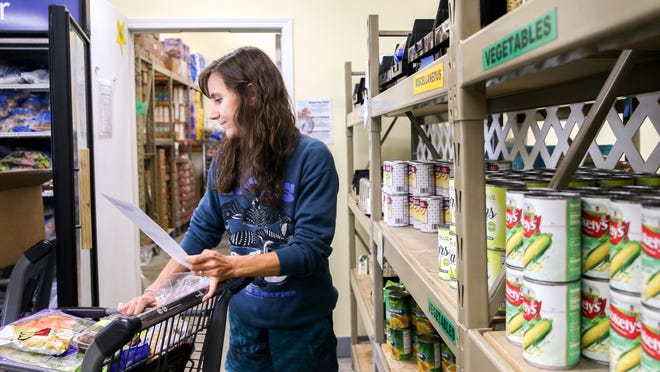
With demand for free food and clothing on the rise, the North Liberty Community Pantry is considering an expansion that would more than triple its storage space.
Executive Director Ryan Bobst said it’s all about him and the food pantry’s staff and volunteers serving families “with dignity and respect.”
Coming to 2023: Food pantries report highest demand ever, more Iowans facing food insecurity

The new house will have four times the space of the current building.
The North Liberty City Council recently approved preliminary site plans for the food pantry’s new 10,500-square-foot facility at 350 W. Penn St.
Bobst said the new location will have 550 square feet of refrigerated storage, a much larger freezer area and about 4,000 square feet of warehouse space.
He said the food pantry’s current site includes a shopping area, staff offices, a reception area and the current warehouse space, which is just about 2,500 square feet.
“It’s great to see this whole building quadruple in size and house a future warehouse,” Bobst said.
Bobst said the new location will be adjacent to the CRANDIC railroad tracks and will be more central to some of the communities the food pantry serves, with many families relying on a partnership with the North Liberty Transportation Assistance Program for free transportation to the food pantry.
Other key facilities at the current location will also relocate to the Penn Street building, including an expanded version of the Growing Together Garden, a family-friendly learning space that will also offer fresh produce.
Read more: High carbon monoxide levels in house fire kill 13 dogs, 2 birds

Giving residents “choices”
Families can shop at the North Liberty Community Pantry once a week, which operates under what Bobst calls a “shopping choice model” — in other words, just like going to any other store or supermarket, except it’s completely free.
Bobst said the pantry strives to stock the five most popular items, including bread, milk, eggs, frozen meat and fresh produce. There are no limits on what area residents can take home.
“Families can take only what they need,” he says. “From an equity standpoint, it’s really great to work with them on that, especially for larger families, because a limit of a dozen or two dozen eggs per person might be enough for a week, but it’s not enough for a family of 10.”
The majority of the pantry’s items come from donations.
Bobst said demand for food delivery, particularly grocery deliveries, has skyrocketed in recent years.
He said more than 95% of the families the pantry serves don’t have reliable transportation, are disabled or too elderly to shop, meaning the pantry will deliver an estimated 2,500 grocery orders this year.
The pantry also has a small but well-stocked clothing section, with most items donated by the community and the only thing the pantry purchases is new underwear, Bobst said.
But the space is completely insufficient for both the supply they have and the demand they meet.
More: Iowa City buys townhouses, police add crime analyst, more big news from City Council

The current space is not large enough to meet demand.
Bobst said the food pantry has no shortage of food options, available clothing and staff available to assist families with a variety of housing and food needs.
But as demand for food increases, the 10-year-old building is running out of storage space.
“Maybe seven years ago, we were out of touch with the space from a capacity standpoint,” Bobst said.
A few tall shelves house most of the food, but Bobst said there isn’t enough space to store all the food the pantries stock and distribute each week. Pallets of boxes are packed into the aisles around the shelves.
There are three standard refrigerators lined up against the wall, and in the back corner is a small freezer where they store everything they can.
Bobst said Field Day Brewing and the Fairway store in North Liberty graciously allowed them to use their food pantry freezers to store surplus catfish and fish stick ingredients.
Also, in rare cases, refrigerated or frozen foods are not stored in the pantry.
“We’ve had to turn away food because it would spoil before it could even get to the families,” Bobst said. “We don’t want to be in that position.”
Bobst said the food pantry is a vital resource for residents and Johnson County as a whole: In a February 2024 survey, about 85% of respondents said they get the majority of their groceries from the pantry.
“We’re no longer a supplemental resource,” Bobst said. “We’re the primary source of food for the majority of families, and we’re on track to feed more than 1,000 families this year.”

Ryan Hansen covers local government and crime for the Press Citizen and can be reached at trhansen@press-citizen.com or on X (formerly Twitter) @ryanhansen01.


